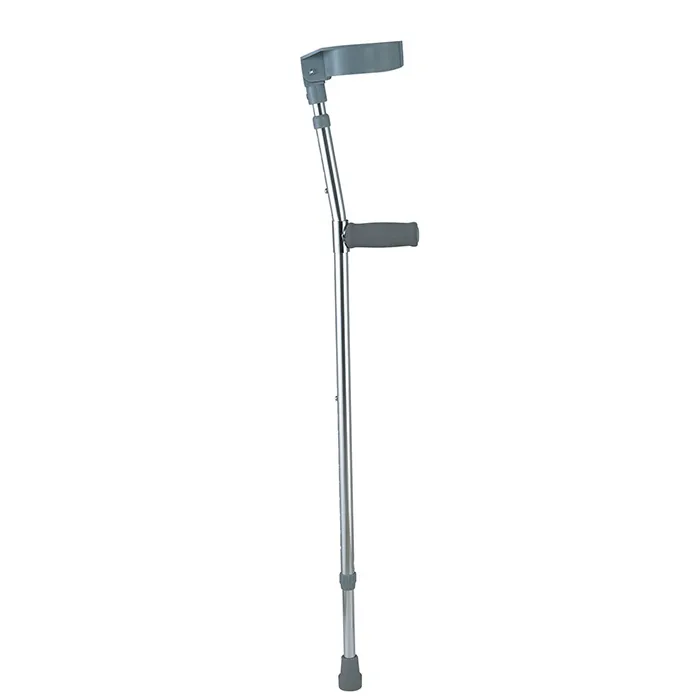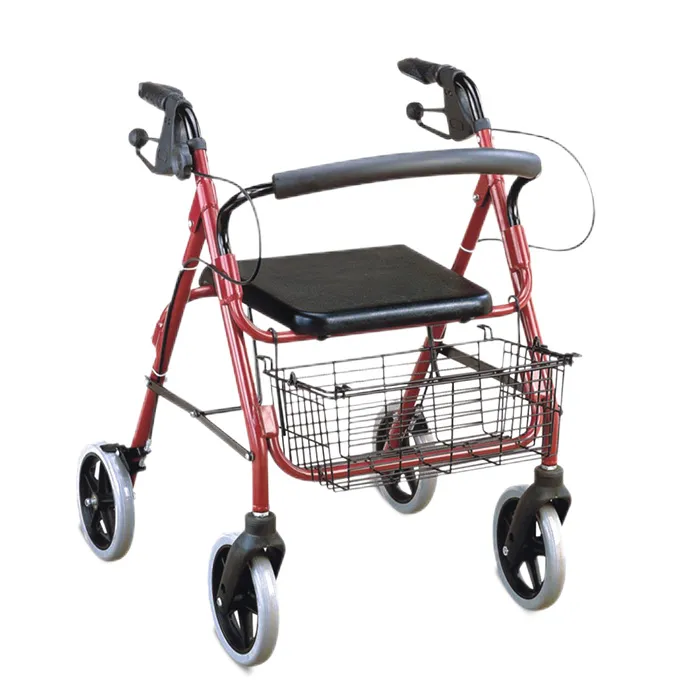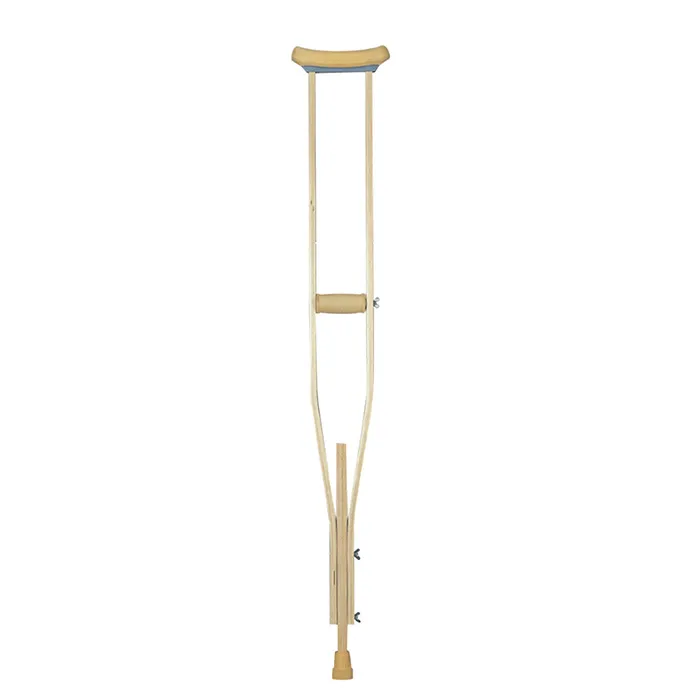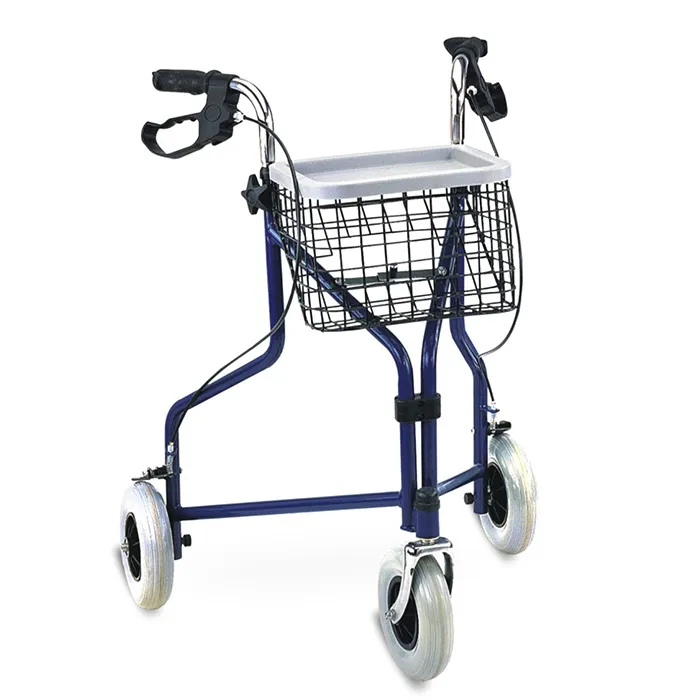Among many assistive devices, "walking stick" and "rollator walker" are the two most common and widely used types. For people with limited mobility, postoperative rehabilitation or the elderly, is it more appropriate to choose a walking stick or a rollator walker (also known as a rollator walker)? This question is not only related to the convenience and safety of travel, but also to long-term health management and quality of life.
This article will start from multiple professional dimensions and deeply analyze the functional differences, applicable population, user experience, safety, portability, support effect, muscle participation and other aspects of walking sticks and rollator walkers, striving to provide users with a scientific and objective evaluation perspective, so as to make a choice that better meets their needs.

What is a walking stick?
A walking stick is a simple walking aid that is often used to provide users with unilateral support to help maintain balance, reduce weight burden and prevent falls. Types of walking sticks include single-leg walking sticks, multi-leg walking sticks, T-shaped walking sticks, curved handle walking sticks and telescopic walking sticks with functional devices. Its structure is lightweight and usually made of aluminum alloy, wood or carbon fiber, which is easy to carry and operate.
What is a rollator walker?
A rollator walker is a frame-type assistive tool that mainly provides full-body support for people with lower limb weakness, poor balance or difficulty walking. Rollator walkers are divided into wheelless, two-wheeled, four-wheeled, etc. according to the number of wheels. Four-wheeled rollator walkers are often equipped with additional functions such as brake systems, seats, baskets, etc. Their design is more complex and suitable for users who need a larger support area and walking stability.
Is it better to use a walking stick or a rollator walker?
Comparison of support stability: rollator walker is better
Walking sticks mainly rely on unilateral or double-handed grip to support part of the user's weight. Its support area is small and it relies more on the user's own balance ability and upper limb strength. The rollator walker provides a wider support surface, and its frame structure can disperse the weight, effectively stabilize the center of gravity, and greatly reduce the risk of falling. It is especially suitable for users with poor balance or postoperative recovery.
The structure of the rollator walker determines that it has a low center of gravity and a wide force-bearing surface, which can give users a stronger sense of security whether it is stationary or moving. In contrast, although the walking stick is flexible, it is slightly lacking in stability.

Walking stick VS. rollator walker: Applicable population analysis
Applicable population of walking stick
The walking stick is more suitable for people with mild walking impairment, unilateral lower limb injury or recovery period. Its design is easy to operate with one hand and does not affect the freedom of the other hand. It is suitable for people who have a slight demand for walking stability in daily life but have good overall physical function. Young people, sports rehabilitation, and mild stroke patients often give priority to walking sticks.
Applicable population of rollator walker
The rollator walker is suitable for users with weak balance ability, decreased muscle strength, and need for all-round support. The elderly, patients recovering from fractures, patients with neurological diseases, and myasthenia groups are more suitable for using rollator walkers. The comprehensive support structure it provides can effectively make up for the lack of physical function and help users complete longer walking activities.
Walking stick VS. rollator walker: Comparison of muscle training effects
Because walking sticks rely on the coordination of the user's upper limbs and trunk, while providing support, they also encourage the body to actively participate in walking activities, strengthen core muscles and balance ability. Long-term use of walking sticks can play a certain role in rehabilitation training, especially for those who still have moderate muscle strength.
Rollator walkers tend to "replace" certain functions of the body to achieve stable support and assist walking. Although rollator walkers reduce the user's physical exertion, they may also reduce muscle participation, which is not conducive to maintaining muscle tension. For users who have completely lost muscle strength, rollator walkers are necessary; but for those with rehabilitation goals, long-term reliance on rollator walkers may lead to muscle degeneration.
Walking stick VS. rollator walker: Comparison of fall prevention ability
Rollator walkers are significantly better than walking sticks in fall prevention. Its structure determines that four or even more points of contact with the ground when walking, and most models are equipped with brakes, anti-dumping devices, and shock absorption systems, which can still keep the equipment stable in unexpected situations. If the walking stick user encounters a sudden loss of balance or the ground is slippery, the single-point support is often difficult to prevent a fall.
In addition, the common "four-wheel + handbrake" configuration of the rollator walker also enhances safety when going downhill or standing. If the walking stick does not have a non-slip bottom design or the user's body position control is poor, it is easy to slip and other risks.

Walking stick VS. rollator walker: flexibility comparison
The walking stick is more flexible in daily life due to its light and simple characteristics. Whether it is going up and down stairs, shuttling through narrow passages, or taking public transportation, the walking stick has more advantages. The user can operate it with one hand and the other hand can carry or hold things.
The rollator walker is larger in size and is inconvenient to operate in a small space. For example, in a small elevator, a narrow door frame, or a crowded crowd, the rollator walker is difficult to move or even impossible to pass. Therefore, if the user's daily life space is narrow or often needs to go out for activities, special consideration should be given to the adaptability of the rollator walker in the space.
Walking stick VS. rollator walker: Portability comparison
Walking sticks have a natural advantage in portability. They are light (usually less than 1 kg), adjustable in length, and some models can be folded or retracted, making them easy to put into backpacks, suitcases, or hang on the side of wheelchairs.
Although some models of rollator walkers can be folded, they are generally large in size and heavy (mostly between 4-10 kg). Both transportation and storage require space considerations. Especially for the elderly, the folding process may be complicated and laborious. In situations where you need to carry it out or travel frequently, walking sticks are obviously more convenient.
Walking stick VS. rollator walker: Cost comparison
Walking sticks have more price advantages. The price of walking sticks generally ranges from tens of yuan to hundreds of yuan, with a variety of types and a low entry threshold. Due to its complex structure and diverse functions, the price of rollator walkers is usually between hundreds of yuan and thousands of yuan. Some advanced rollator walkers even have seats, handbrakes, storage baskets, etc., and the price is relatively higher.
From an economic point of view, walking sticks are more suitable for users with limited budgets. The high cost-effectiveness of the rollator walker is reflected in its multi-functional integration and high safety, which is suitable for long-term users with stable budget support.

Walking stick VS. rollator walker: Comparison of psychological feelings and appearance acceptance
Some users, especially young patients, may have a certain psychological rejection of the "machine feeling" of the rollator walker, thinking that it clearly indicates a physical disability. The walking stick is easier to accept because of its simple shape, diverse colors, and diverse designs, and is even regarded as an accessory or decoration by some users.
In terms of user psychological adaptation, the walking stick may be easier to transition, especially in the initial stage of functional decline. For users who have already accepted assistive devices, the functionality of the rollator walker is often more valued.
Walking stick VS. rollator walker: How to choose?
Whether to choose a walking stick or a rollator walker in the end needs to be comprehensively considered from the following core perspectives:
| Evaluation dimensions | Walking Stick | Rollator Walker |
| Support range | Small (one-sided) | Large (full body support) |
| Balance assistance | General | Excellent |
| Operation flexibility | High | Low to Medium |
| Spatial adaptability | Strong | Weak to Medium |
| Portability | Extremely strong | Fair |
| Usage environment | Indoor/flat/short distance | Outdoor/Long Distance/Complex Terrain |
| User physical requirements | Medium to high | Low |
| Safety | General | High |
| Price | Low | Medium to High |
"Is it better to use a walking stick or a rollator walker?" There is no one-size-fits-all answer. Walking sticks and rollator walkers each have their own advantages. The key lies in evaluating one's own physical condition, usage environment, living habits, and psychological acceptance. People with mild support needs and those who use space frequently are suitable for walking sticks; while those who are physically weak, have reduced balance ability, and have higher requirements for safety are more suitable for rollator walkers.
How long has Yikang Medical been in the industry?
Established in 2010, Foshan Yikang Medical Technology Co., Ltd began as a manufacturer of hardware accessories and machinery. By 2014, we expanded our production to include wheelchairs and hospital beds, becoming a designated OEM supplier for leading brands in the medical industry. With years of expertise, we now offer a wide array of medical and rehabilitation products. As a certified manufacturer, our products are CE, FDA, ISO13485, and ISO9001 certified, ensuring high quality and reliability at affordable prices.

